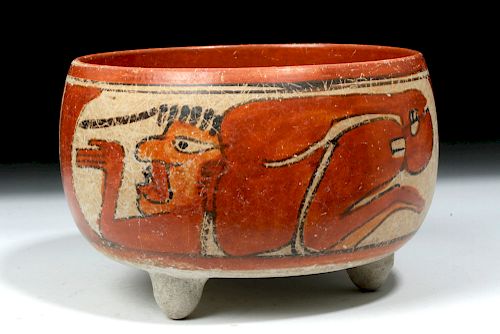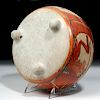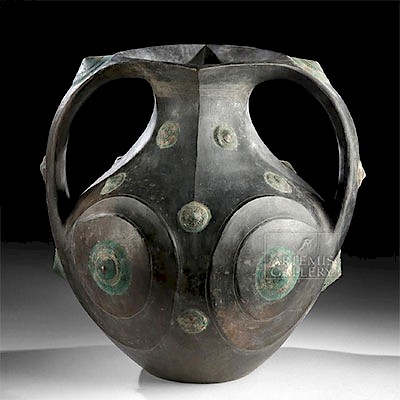Maya Peten Polychrome Footed Bowl, ex-Sotheby’s
Lot 126a
About Seller
Artemis Gallery
686 S Taylor Ave, Ste 106
Louisville, CO 80027
United States
Selling antiquities, ancient and ethnographic art online since 1993, Artemis Gallery specializes in Classical Antiquities (Egyptian, Greek, Roman, Near Eastern), Asian, Pre-Columbian, African / Tribal / Oceanographic art. Our extensive inventory includes pottery, stone, metal, wood, glass and textil...Read more
Estimate:
$12,000 - $15,000
Absentee vs Live bid
Two ways to bid:
- Leave a max absentee bid and the platform will bid on your behalf up to your maximum bid during the live auction.
- Bid live during the auction and your bids will be submitted real-time to the auctioneer.
Bid Increments
| Price | Bid Increment |
|---|---|
| $0 | $25 |
| $300 | $50 |
| $1,000 | $100 |
| $2,000 | $250 |
| $5,000 | $500 |
| $10,000 | $1,000 |
| $20,000 | $2,500 |
| $50,000 | $5,000 |
| $100,000 | $10,000 |
| $200,000 | $20,000 |
About Auction
By Artemis Gallery
Jul 11, 2019
Set Reminder
2019-07-11 10:00:00
2019-07-11 10:00:00
America/New_York
Bidsquare
Bidsquare : Ancient / Ethnographic / Americana
https://www.bidsquare.com/auctions/artemis-gallery/ancient-ethnographic-americana-4246
Discover ancient art from Egypt, Greece, Italy, and the Near East, as well as Asian, Pre-Columbian, Tribal, Fossils and Fine Art. Also featuring a wonderful collection from a prominent New York estate whose owners reside in the Van Wyck family's historic Lloyd Harbor waterfront home. Artemis Gallery info@artemisgallery.com
Discover ancient art from Egypt, Greece, Italy, and the Near East, as well as Asian, Pre-Columbian, Tribal, Fossils and Fine Art. Also featuring a wonderful collection from a prominent New York estate whose owners reside in the Van Wyck family's historic Lloyd Harbor waterfront home. Artemis Gallery info@artemisgallery.com
- Lot Description
Pre-Columbian, Mexico and Guatemala, Peten Basin, Maya Late Classic Period, ca. 550 to 950 CE. A thin walled ceramic bowl with polychrome motifs ringing the exterior showing two prone human figures engaging in an enema ritual in order to ingest hallucinogenic drugs. The interior of the bowl is painted a deep, spectacular red, similar to the figures' skin. They are depicted unclothed aside from belts. Their faces are orange and their hair juts out from the front of their heads, elaborately coiffured in a spiral form. The bowl stands on three stubby, rounded legs that are buff clay rather than painted. Size: 6.4" W x 4.35" H (16.3 cm x 11 cm)
The Peten region was one of the most densely populated regions in the world during the Maya period, home to several million people and many powerful urban areas, with their own distinctive art style. According to Peter deSmet, author of "Ritual Enemas and Snuffs in the Americas", many pre-Columbian societies practiced the ritual insertion of enemas (clyster) of alcohol and hallucinogens in order to enter an altered state of consciousness and partake in shamanic and religious rituals. The Maya created their enemas by keeping bees in order to produce honey and create fermented drinks like the strong, anise-flavored Xtabentun.
Published in Robicsek, F., "The Smoking Gods: Tobacca in Maya Art, History, and Religion", University of Oklahoma Press, 1978, color plate #21.
Provenance: private Stanley Marcus collection; ex-Sotheby's, New York, November 16, 2002, Lot 40
All items legal to buy/sell under U.S. Statute covering cultural patrimony Code 2600, CHAPTER 14, and are guaranteed to be as described or your money back.
A Certificate of Authenticity will accompany all winning bids.
We ship worldwide and handle all shipping in-house for your convenience.
#124790Two tiny repaired chips on inside of rim. Very clear artwork as shown and gorgeous root marks on the buff underside.Condition
- Shipping Info
-
All shipping is handled in-house for your convenience. Your invoice from Artemis Gallery will include shipping calculation instructions. If in doubt, please inquire BEFORE bidding for estimated shipping costs for individual items.
-
- Buyer's Premium



 EUR
EUR CAD
CAD AUD
AUD GBP
GBP MXN
MXN HKD
HKD CNY
CNY MYR
MYR SEK
SEK SGD
SGD CHF
CHF THB
THB
















